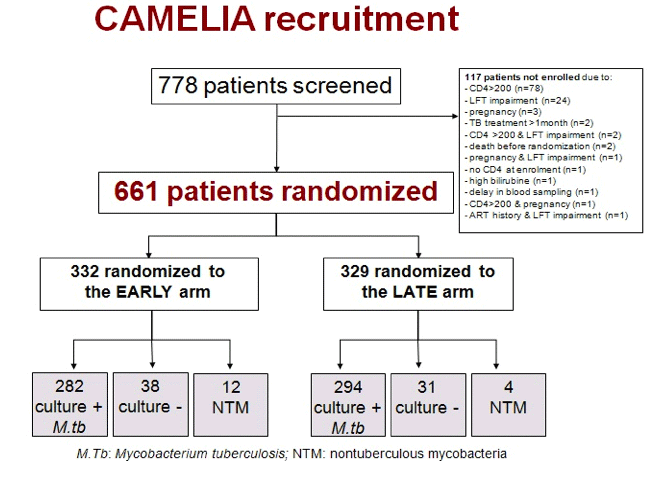 |
 |
 |
| |
Significant enhancement in survival with early (2 weeks) vs. late (8 weeks) initiation of highly active antiretroviral treatment (HAART) in severely immunosuppressed HIV-infected adults with newly diagnosed tuberculosis: "34% Reduction in Mortality in Early Arm"
|
| |
| |
Reported by Jules Levin, 18th Intl AIDS Conf, July 18-23, Vienna Austria
F.X. Blanc1, T. Sok2, D. Laureillard2,3, L. Borand4, C. Rekacewicz5, E. Nerrienet4, Y. Madec6, O. Marcy2, S. Chan2, N. Prak7, C. Kim8,9, K.K. Lak2,10, C. Hak11, B. Dim2,9,12, C.I. Sin13, S. Sun2,10, B. Guillard4, B. Sar4, S. Vong4, M. Fernandez2, L. Fox14, J.F. Delfraissy5, A.E. Goldfeld2,15


Rapporteur report Andrew KAMBUGU: Blanc et al. presented the highly significant results of the landmark CAMELIA trial that examined a very sick group of patients diagnosed with HIV/TB (median CD4 25, all pts had CD4<200, most with pulmonary or pulmonary+extrapulmonary TB). Patients (n=661) were started on standard TB therapy, randomized to also begin ART at either 2 weeks or 8 weeks of TB therapy. Patients starting early (2 weeks) ART had much higher probabilities of surviving to 50, 100 and 150 weeks than patients who started ART at 8 weeks. The hazard ratio for death with late treatment, even after controlling for various other factors like drug resistant TB, low BMI and low Karnofsky score, remained 1.52, highly significant. While IRIS to TB was almost three-fold higher incidence in the early treatment group, it was always easily treated. Authors and audience agreed that this and prior studies strongly advocate for early ART in patients receiving TB therapy, and should help eliminate TB IRIS as a potential barrier to initiating ART, as it appears to be clinically manageable, and the mortality benefit appears to be dramatic.
1Pneumology Unit, Internal Medicine Department, Bicetre Hospital, Assistance Publique - Hopitaux de Paris, Le Kremlin-Bicetre, France, 2Cambodian Health Committee, Phnom Penh, Cambodia, 3European George Pompidou Hospital, Assistance Publique - Hopitaux de Paris, Paris, France, 4Institut Pasteur in Cambodia, Phnom Penh, Cambodia, 5Agence Nationale de Recherche sur le SIDA et les hepatites virales (ANRS), Paris, France, 6Institut Pasteur, Paris, France, 7Khmer Soviet Friendship Hospital, Infectious Diseases Department, Phnom Penh, Cambodia, 8Donkeo Provincial Hospital, Takeo, Cambodia, 9Medecins Sans Frontieres, Cambodia, Phnom Penh, Cambodia, 10Svay Rieng Provincial Hospital, Svay Rieng, Cambodia, 11Calmette Hospital, Phnom Penh, Cambodia, 12Siem Reap Referral Hospital, Siem Reap, Cambodia, 13Khmer Soviet Friendship Hospital, Pneumology Department, Phnom Penh, Cambodia, 14Division of AIDS, NIAID, National Institutes of Health (NIH), Bethesda, United States, 15Harvard Medical School, Boston, United States
ABSTRACT
Background: Tuberculosis (TB) remains the largest cause of death among people living with HIV/AIDS, especially among those with profound immunosuppression. Case-fatality among co-infected patients occurs mainly in the first months after TB treatment initiation. Therefore, robust data regarding optimal timing of HAART initiation within this early period are critically needed.
Methods: CAMELIA (CAMbodian Early vs. Late Introduction of Antiretroviral drugs: ANRS 1295/12160-CIPRA KH001/10425), an open-labelled randomized clinical trial, was designed to compare the impact upon mortality of early (2 weeks) vs. late (8 weeks) HAART initiation after TB treatment onset in treatment-naïve adults with newly diagnosed acid-fast bacilli (AFB) positive TB and CD4+ cell count < 200 cells/mm3. Patients received standard 6-month TB treatment plus stavudine, lamivudine and efavirenz in 5 sites in Cambodia and were followed through 50 weeks after the last patient was enrolled. A log-rank test was used to compare Kaplan-Meier survival curves.
Results: 661 patients (early, n=332; late, n=329) were enrolled. Median age was 35 years, body mass index 16.7 kg/m2, CD4+ cell count 25 cells/mm3 and viral load 5.64 log copies/ml. All AFB-positive samples, including sputum in 538 (81.4%) patients, were cultured. As of May 13, 2010, 146 patients were known dead (59, early arm; 87, late arm). Enhanced survival was observed in the early arm (p< 0.01, figure). At week 50, median CD4+ gain was 114 cells/mm3; 96.5% of patients had an undetectable viral load.
Conclusions: Initiation of HAART 2 weeks after onset of TB treatment significantly improves survival in severely immunosuppressed HIV-infected adults with newly diagnosed TB.




evidence








'IRIS was easy to manage and usually occurred 2-3 weeks after HAART started regardless of which arm'




|
| |
|
 |
 |
|
|